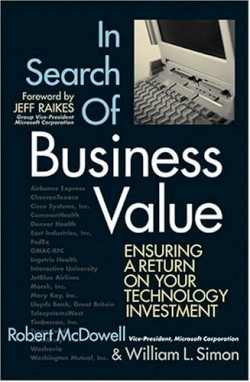In Search of Business Value
Ensuring A Return on Your Technology Investment
Technology is necessary for any type of organization, regardless of its size. This book discusses how to get maximum value from technology investments. Although the authors’ experience is with large corporations, they wisely recognize that justifying technology expenditures in small companies can be just as challenging. McDowell is a vice president at Microsoft and a former partner with Ernst & Young. Simon is a bestselling author of more than a dozen books, including The Art of Deception, co-written with computer hacker Kevin Mitnick.
McDowell has strong convictions on the subject of technology use. “I still find examples of CEOs and other C-level officers who refuse to have anything to do with technology,” he says. He believes that corporate CEOs and CIOs need to utilize technology to help solve business problems by exploring best-practice techniques. “If you’re a senior business leader today and you’re not at least basically literate technically,” McDowell asserts, “then you’re unqualified to fill your position.”
The authors’ previous book, Driving Digital, featured companies that have effectively used technology in the E-business era. This volume builds on that concept and suggests best practices for achieving technology value by presenting advice from leaders of business and IT organizations. What sets this book apart are the case studies illustrating how companies can save money and gain competitive advantage through technology. In one example, Telesystems saved $100 million per year by equipping its technicians with home computers, Internet connections, and voice-over IP connections. In another, a spokesperson from Airborne, the package delivery company, tells how the firm developed a software solution for improved package tracking that enables the company to offer tracking service to its customers at no additional charge and gives Airborne a competitive advantage.
McDowell and Simon look beyond the obvious to show how companies are proactively coming up with ways of justifying technology expenditures. Besides conventional return-on-investment metrics, companies such as Washington Mutual consider other advantages such as “employee enablement,” and the U.S. Army justifies technology deployment as a matter of “survival.”
The second half of the book examines the importance of establishing a governance program for IT and business units to jointly determine and execute technology strategy. It cites companies such as Cisco and Tyson Foods that have established governance committees and processes and shares their valuable lessons learned.
Many good ideas are divulged in this book. For example, Washington Mutual’s CIO Jerry Gross implemented “quick-hit deliverables” monthly so that the business people could frequently see the value delivered by IT, and he piloted new technology from the top down starting with the support of upper management.
Chapters end with “take-aways,” useful summaries and practical advice. The book is a quick and easy read and the examples are current. Readers in search of business value will certainly find it in this book.
Reviewed by
Cindy Kryszak
Disclosure: This article is not an endorsement, but a review. The publisher of this book provided free copies of the book to have their book reviewed by a professional reviewer. No fee was paid by the publisher for this review. Foreword Reviews only recommends books that we love. Foreword Magazine, Inc. is disclosing this in accordance with the Federal Trade Commission’s 16 CFR, Part 255.

